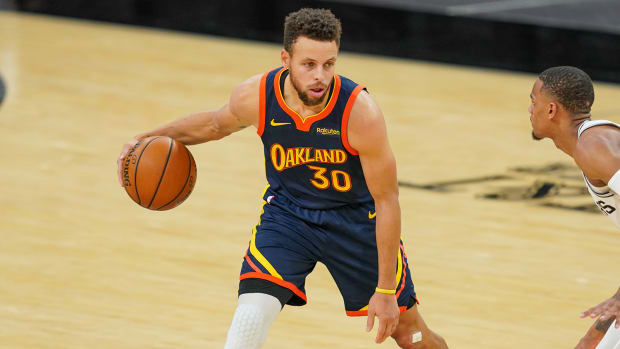Coming into the season, critics questioned whether Curry could return to MVP form. Through 25 games he has been downright brilliant.
It’s tempting to look for a parallel, however strained, between the current iteration of the Warriors and the group that began a thrilling run to five straight Finals in 2014. Seven years ago, an injury to two-time All-Star David Lee forced third-year forward Draymond Green into Golden State’s starting lineup, and Green has started every game of his career since as a two-way, do-it-all, one-man wrecking crew. The emergence of Draymond also eventually led to the genesis of the Death Lineup, the Warriors’ small-ball group with Green at center that terrorized the NBA for five seasons, particularly when Kevin Durant joined the team.
At the end of January, rookie big man James Wiseman injured his left wrist, leaving Golden State with no traditional centers as Wiseman and Kevon Looney were both hurt. All of a sudden, the Warriors were being forced to play small again, and over the last five games, the results have been promising. The team is only 2–3, but the two wins have been by a combined 54 points, and the three losses by a combined nine. And in that stretch, Stephen Curry has been so dominant, he’s nudging his way into the fringe of the MVP conversation, averaging 37.4 points, 5.4 assists and 5.4 rebounds per game in his last five contests, while shooting a mind-boggling 50% from three on nearly 13 attempts a night.
And yet, any wishful thinking that the Warriors may be recapturing their dynastic magic actually does a disservice to the real reason they are anywhere near competent right now. And that reason is Curry.
It’s hard to overstate the degree of difficulty with which Curry is navigating through this season. He hasn’t played a minute alongside the second-best player on the team, Klay Thompson, since Game 5 of the 2019 NBA Finals. Juan Toscano-Anderson, admirably starting in the frontcourt in Wiseman’s absence, is a 27-year-old on a two-way contract who had only 13 games of NBA experience before this season. Kelly Oubre Jr. is the ultimate boom or bust player, shooting 37.7% from three in the team’s 13 wins but only 20.3% in their 12 losses, with most of those looks being open every night. And Green, for all his legitimate genius on both ends of the floor, is Benjamin Buttoning as a scorer, averaging his fewest points, shot attempts and worst field-goal percentage since his rookie season.
The indefatigable Curry continues to lift this team. His supporting cast may be wily, but it’s also clearly limited. And at the same time, his coach and organization are committed to being judicious with his playing time. Curry plays only 33.7 minutes per game, 31st in the NBA, behind the likes of Tyler Herro, RJ Barrett or Cavs rookie Isaac Okoro.

Through all the obstacles, Curry remains brilliant. He is currently the most efficient pick-and-roll ballhandler in the league of players running at least four of them a game, generating 1.21 points per possession, with the Warriors leaning on that action more than ever before. With the ball in his hands, Curry is still one of the most difficult covers in the league. He is punishing bigs who dare to switch on him, and just like in the halcyon days of the Finals runs, Curry is quick to dish to Green in a four-on-three situation if an opponent sends two defenders at him. (Watching Curry work against centers is particularly delightful, as he constantly weaponizes the threat of his three-point shooting to snake into the lane for a layup.)
With a smaller lineup and somewhat more space around him, Curry is finally doing the James Harden impression critics wondered if he could ever pull off himself, and he’s doing so better than Harden himself is this season. And in between the pick and rolls, Curry hasn’t stopped his constant motion off the ball, still often creating easy looks for his teammates with a well-placed screen or a fast-paced curl. If a Warrior receives a bullet pass from Green and finds himself in the paint free of any defenders, it’s probably because his man decided to chase Curry instead.
Sometimes, it almost feels as if the Warriors are holding Curry back, or maybe taking his greatness for granted. The lineups haven’t always been optimized this season. The long stretches of the fourth quarter when Curry doesn’t play have been baffling. And there are times when putting him off the ball feels a little bit more galaxy brain than wise strategy. Warriors coach Steve Kerr was absolutely dealt a tough hand once Thompson tore his Achilles, but he could probably afford to be more aggressive with one of the best players in the world.
And that’s really what this season comes down to for the Warriors. There were questions about Curry headed into this season. Here was a small guard, with five Finals trips’ worth of minutes on his body, coming off an injury, playing on a roster severely hampered by injury. What did Curry have left?
Well, the first 25 games of this season have shown Curry hasn’t dropped off. He’s putting up numbers that come close to his unanimous MVP campaign in 2016. With the parts around him changing rapidly, he can still lead the team to success, because he is Golden State’s system. The parallel between the current Warriors and the one your older sibling remembers isn’t that random circumstance helped push them to a new level. It’s that Curry, now, as he was then, seemingly no matter what you put around him, remains one of the most impactful superstars the league has ever seen.